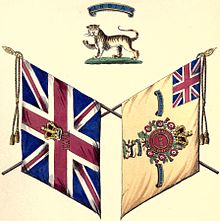67th (South Hampshire) Regiment of Foot
| 67th (South Hampshire) Regiment of Foot | |
|---|---|

Colours of the 67th Regiment
|
|
| Active | 10 December 1756–1 July 1881 |
| Country |
|
| Branch |
|
| Type | Line infantry |
| Size | One battalion (two battalions 1803–1817) |
| Garrison/HQ | Lower Barracks, Winchester |
| Colors | Facings: Pale yellow |
| Engagements |
Napoleonic Wars Second Opium War Second Anglo-Afghan War |
The 67th (South Hampshire) Regiment of Foot was a line infantry regiment of the British Army, raised in 1756. Under the Childers Reforms it amalgamated with the 37th (North Hampshire) Regiment of Foot to form the Hampshire Regiment (later the Royal Hampshire Regiment) in 1881.
The formation of the regiment was prompted by the expansion of the army as a result of the commencement of the Seven Years' War. On 25 August 1756 it was ordered that a number of existing regiments should raise a second battalion; among those chosen was the 20th Regiment of Foot. The 2nd Battalion of the 20th Regiment of Foot was formed on 10 December 1756 and renumbered as the 67th Regiment of Foot on 21 April 1758. In spring 1761 the regiment formed part of a force which successfully captured Belle Île. It embarked for Portugal in 1762 and moved on to Minorca in 1763. After returning home in 1771, it was posted to Ireland in 1775. In 1782 the regiment took a county title as the 67th (South Hampshire) Regiment of Foot.
In 1785 the regiment was posted to the West Indies: it arrived at Barbados and then moved to Antigua in autumn 1785. It moved to Grenada in 1788 and returned to Barbados in 1793 before travelling home in 1794.
The regiment returned to the West Indies in 1795 and helped but down a rebellion in Saint-Domingue in 1796. It moved to Jamaica in 1798 and then with numbers depleted by disease returned to England in 1801. In July 1803 a second battalion was raised. The 1st battalion embarked for India in April 1805 and took part in the closing stages of the Siege of Ryghur in May 1818 and most of the Siege of Asirgarh in March 1819 during the Third Anglo-Maratha War.
...
Wikipedia
